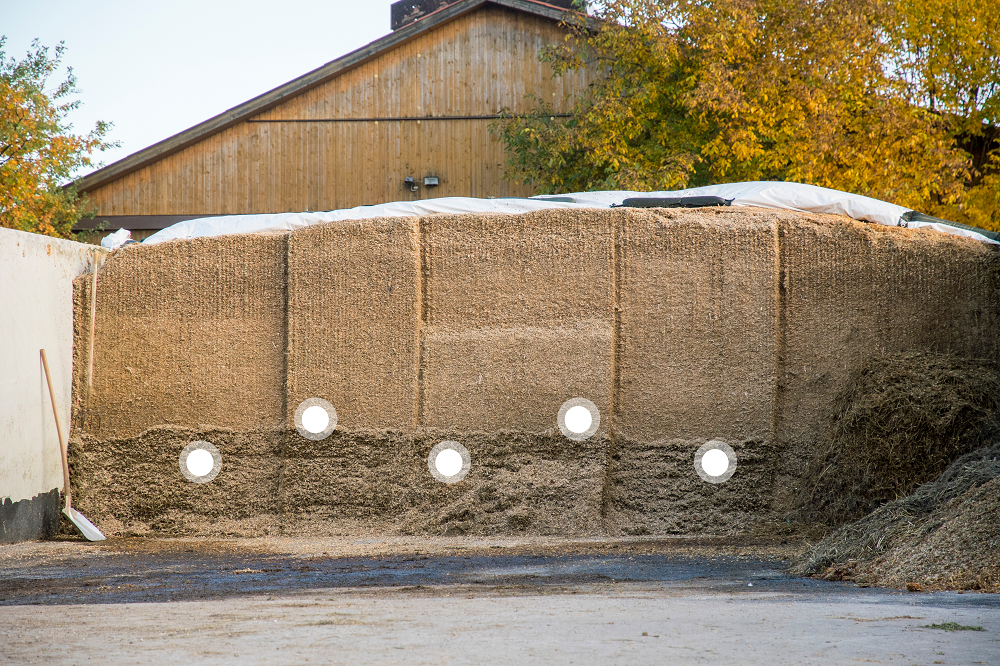Molds produce a wide range of secondary metabolites, commonly called mycotoxins. The presence of these mycotoxins is never homogenous with areas of high concentrations—called ‘hot spots’—and areas free of toxins. This heterogeneity makes it hard to collect a representative sample for analysis, particularly because mycotoxins are produced in the field (Fusarium) and during storage (Penicillium and Aspergillus).
With various species and changing environments, it is difficult to estimate the exact origin and level of mycotoxin contamination. Therefore, regular sampling of raw materials and complete feed—preventively and when mycotoxin contamination is suspected—is recommended.
Testing is only as good as the sample used. Unfortunately, it is estimated that a representative sample for mycotoxin analysis would require an initial sample of more than 20 kg for every 100 tons of feed/grain. With current testing methods, more than 97% of errors regarding mycotoxin contamination probably come from sampling errors. To determine which ingredients are contaminated, or when mycotoxins levels increase during feed preparation, it is necessary to take samples in the following areas:
The more sample points collected when sampling, the more representative the results will be. When few incremental samples are gathered, or the total lot size of the sample is too small, it is more common to “lose” contaminated grain than to “find” it. Therefore, knowing proper sampling techniques is vital to understanding your mycotoxin situation. An ideal collection process for 20-50 mT of grain is as follows.
Upon arrival, it is advised to take samples from trucks or railroad cars prior to/during unloading. Use a bulkhead gauge or probe with a minimum length of 1.5 meters and a minimum of ten compartments. Take samples in the areas marked by ‘X’ in the diagram below (Figure 1). The probe should go as deep as possible to obtain samples from multiple layers. After probing, the total weight of all the samples taken needs to be at least 10 Kg for 20–50 mT trucks and at least 6 kg for 13–20 mT trucks. From here, follow the quartering instructions as described above.
*If taking manual samples, be sure to follow standard safety practices.


Figure 1: Be sure to capture samples from throughout the grain container and at various depths
Once the grain or raw material enters the feedmill, it is advised to take ‘dynamic’ or moving material samples during the manufacturing process.
Depending on the structure of the mill, drill a 3 cm diameter hole in the bottom of the conveyor that carries the ground raw material to the storage tanks for mixing. Then, fit a stopcock to open/close the space. When the raw material passes through the conveyor, open the tap for the product to drop into a collection container. Ensure this container can be accessed and removed for easy handling.
In a mill setting, for every 30 mT that passes through the pipe, a minimum of a 10 kg sample must be taken from throughout the load and halved with the preparation technique described above. It helps to have this pipe easily accessible for cleaning and it must be placed on the raw materials conveyor. It is best practice to sample incoming grain, grain that has been in storage, and outbound finished products. The sampling containers must be properly washed between samples and disinfected to avoid contamination.

The best practice is to use a drill with a hollow forage probe attachment. Be sure to pull your samples from a freshly shaved pile or bunker face and to drill at least 60 cm into the pile in six to seven points at about hip level and as high as you can safely reach from the ground. Once the samples are taken, mix and halve according to the above instructions. Be sure to remove excess air from the final sample prior to shipping.
If there is a noticeable harvest line in the face, if safely possible, be sure to sample both above and below the line.

If you cannot effectively take samples from the face of a pile or bunker, another option is to walk across the top and take samples similar to a container (Figure 1). Gather samples with a hollow forage probe attachment on a drill.
Though possible, this system is not ideal as the outer surface of a bunker is more prone to air exposure, which will not be a representative sample of the internal portion of the pile. Also, due to the build-up method when creating piles, the outer surface will not align with a representative sample of all portions of the feed but simply the last field harvested. If applying this method, re-seal all holes with strong tape. In the process, check for additional air holes created by birds or animals.
*Be sure to practice appropriate bunker face management. Ensure there are no cracks or overhangs when working close to the face and that someone is monitoring in case of a collapse.
Though a low risk of mycotoxins—as molds and fungi prefer the carbohydrates stored in grain—if hay, grass, or straw is suspected, samples can be collected using a hay probe for both square and round bales. When taking samples of bales, probe the side of round bales and the end of large square bales. Also, take samples from 8 to 12 bales before mixing and halving as instructed above.
After distributing the feed (but before the animal has consumed and contaminated the feed) take samples with one of the following methods:

Take a sample of 50 to 100 g of feed from every feeder in the poultry house. Once collected, mixed and split as explained above to obtain the final volume of 500 g of feed for the lab.

On pig farms, take 50 to 100 g from each feeder (best to take from the hopper). Once collected, all the samples are mixed and split, as explained above, to obtain a final volume of 500 g for the lab.

Walk the feeding lane and pull a loose handful of feed every 7–10 steps, depending on the size of the barn. Mix and split evenly until 500 g remains, package in an airtight bag for the lab.
Despite preventive measures, most feedstuffs are contaminated by at least one mycotoxin in the field, and this number exponentially increases by the time it reaches the farm. A study by North Carolina State University found corn samples from the field were 30% positive for mycotoxins. Followed to the feed mill, the same grain was 52% positive for mycotoxins and 91% positive by the time it arrived on the farm in the feeders. The increase of storage toxins results in an added risk to the animals that consume them. Although mycotoxin formation is strongly correlated with geographical regions, global trade causes cross-contamination of most mycotoxins all over the world.
Would you like to be kept informed of our latest developments? Register here and stay up to date.
"*" indicates required fields
| Cookie | Duration | Description |
|---|---|---|
| cookielawinfo-checkbox-analytics | 11 months | This cookie is set by GDPR Cookie Consent plugin. The cookie is used to store the user consent for the cookies in the category "Analytics". |
| cookielawinfo-checkbox-functional | 11 months | The cookie is set by GDPR cookie consent to record the user consent for the cookies in the category "Functional". |
| cookielawinfo-checkbox-necessary | 11 months | This cookie is set by GDPR Cookie Consent plugin. The cookies is used to store the user consent for the cookies in the category "Necessary". |
| cookielawinfo-checkbox-others | 11 months | This cookie is set by GDPR Cookie Consent plugin. The cookie is used to store the user consent for the cookies in the category "Other. |
| cookielawinfo-checkbox-performance | 11 months | This cookie is set by GDPR Cookie Consent plugin. The cookie is used to store the user consent for the cookies in the category "Performance". |
| viewed_cookie_policy | 11 months | The cookie is set by the GDPR Cookie Consent plugin and is used to store whether or not user has consented to the use of cookies. It does not store any personal data. |
